Customer Perception and Organized Retailing: A Case Study of ASDA
VerifiedAdded on 2023/04/22
|59
|20295
|279
Report
AI Summary
This report presents a comprehensive case study on the impact of organized retailing on customer perception, specifically focusing on ASDA. The study employs a descriptive research design with a quantitative approach, utilizing a deductive research approach and interpretivism as the research philosophy. Primary data was collected through questionnaires from a sample size of 40 ASDA customers, and frequency data analysis was used to evaluate the collected data. The research investigates factors influencing organized retailing, such as changing customer expectations and the rise in working women, and how elements like product variety and store layout encourage purchase decisions. The findings reveal a strong correlation between organized retailing operations and shifts in customer perceptions, ultimately influencing purchasing behavior. The report concludes by highlighting the positive changes ASDA's organized retailing concept has brought to customer perceptions and offers recommendations for future strategies to enhance customer management and address market competition.
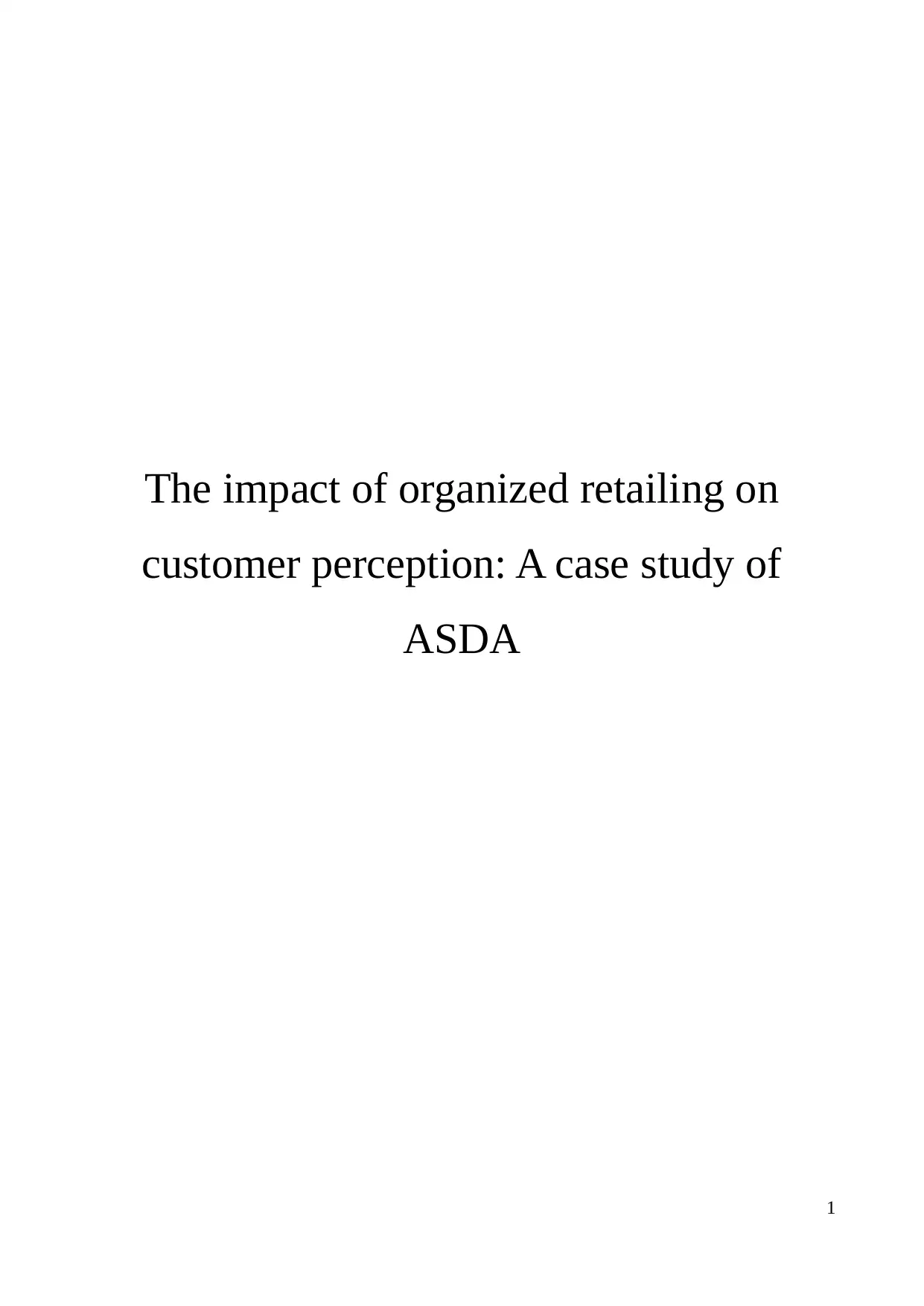
The impact of organized retailing on
customer perception: A case study of
ASDA
1
customer perception: A case study of
ASDA
1
Paraphrase This Document
Need a fresh take? Get an instant paraphrase of this document with our AI Paraphraser
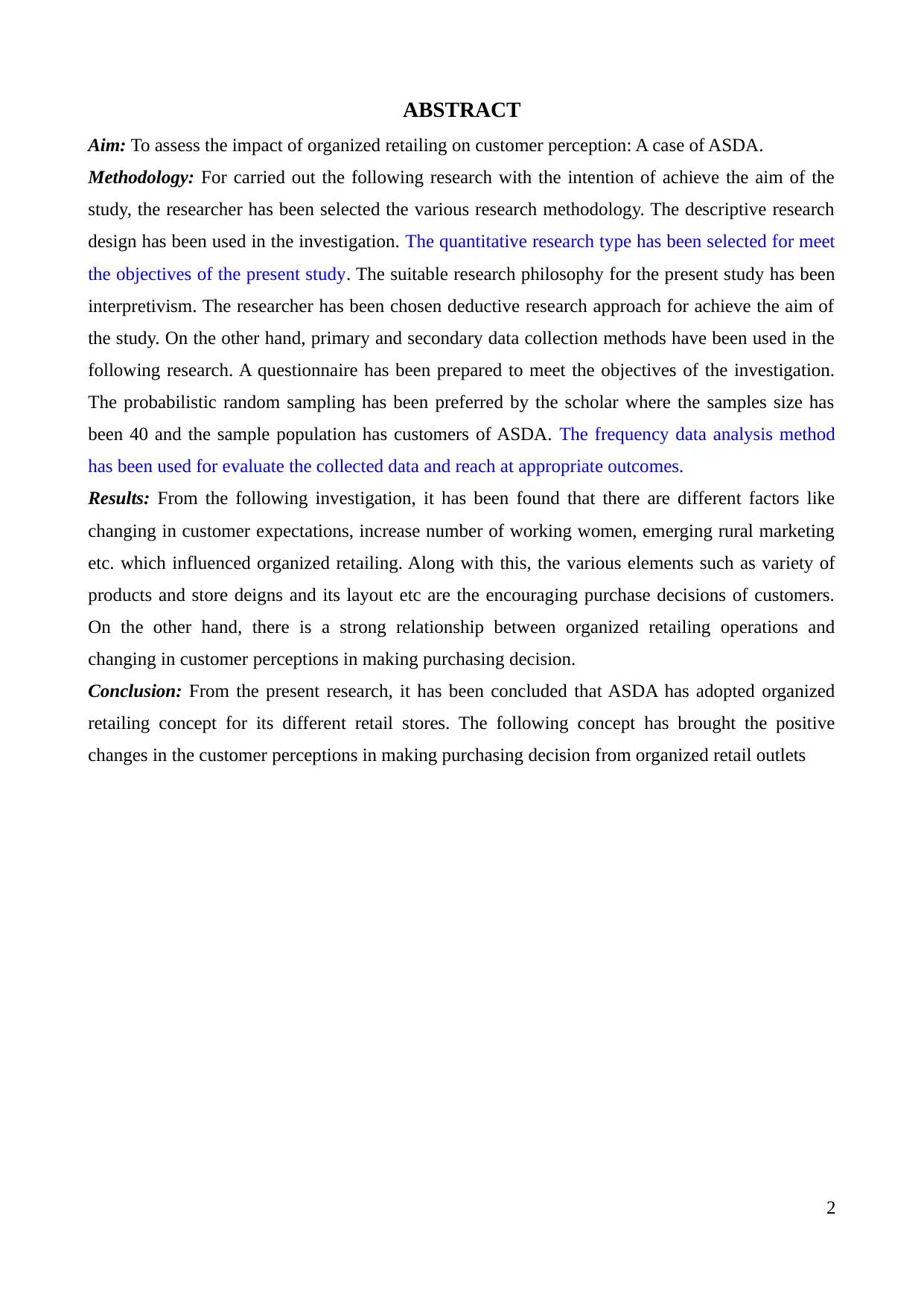
ABSTRACT
Aim: To assess the impact of organized retailing on customer perception: A case of ASDA.
Methodology: For carried out the following research with the intention of achieve the aim of the
study, the researcher has been selected the various research methodology. The descriptive research
design has been used in the investigation. The quantitative research type has been selected for meet
the objectives of the present study. The suitable research philosophy for the present study has been
interpretivism. The researcher has been chosen deductive research approach for achieve the aim of
the study. On the other hand, primary and secondary data collection methods have been used in the
following research. A questionnaire has been prepared to meet the objectives of the investigation.
The probabilistic random sampling has been preferred by the scholar where the samples size has
been 40 and the sample population has customers of ASDA. The frequency data analysis method
has been used for evaluate the collected data and reach at appropriate outcomes.
Results: From the following investigation, it has been found that there are different factors like
changing in customer expectations, increase number of working women, emerging rural marketing
etc. which influenced organized retailing. Along with this, the various elements such as variety of
products and store deigns and its layout etc are the encouraging purchase decisions of customers.
On the other hand, there is a strong relationship between organized retailing operations and
changing in customer perceptions in making purchasing decision.
Conclusion: From the present research, it has been concluded that ASDA has adopted organized
retailing concept for its different retail stores. The following concept has brought the positive
changes in the customer perceptions in making purchasing decision from organized retail outlets
2
Aim: To assess the impact of organized retailing on customer perception: A case of ASDA.
Methodology: For carried out the following research with the intention of achieve the aim of the
study, the researcher has been selected the various research methodology. The descriptive research
design has been used in the investigation. The quantitative research type has been selected for meet
the objectives of the present study. The suitable research philosophy for the present study has been
interpretivism. The researcher has been chosen deductive research approach for achieve the aim of
the study. On the other hand, primary and secondary data collection methods have been used in the
following research. A questionnaire has been prepared to meet the objectives of the investigation.
The probabilistic random sampling has been preferred by the scholar where the samples size has
been 40 and the sample population has customers of ASDA. The frequency data analysis method
has been used for evaluate the collected data and reach at appropriate outcomes.
Results: From the following investigation, it has been found that there are different factors like
changing in customer expectations, increase number of working women, emerging rural marketing
etc. which influenced organized retailing. Along with this, the various elements such as variety of
products and store deigns and its layout etc are the encouraging purchase decisions of customers.
On the other hand, there is a strong relationship between organized retailing operations and
changing in customer perceptions in making purchasing decision.
Conclusion: From the present research, it has been concluded that ASDA has adopted organized
retailing concept for its different retail stores. The following concept has brought the positive
changes in the customer perceptions in making purchasing decision from organized retail outlets
2
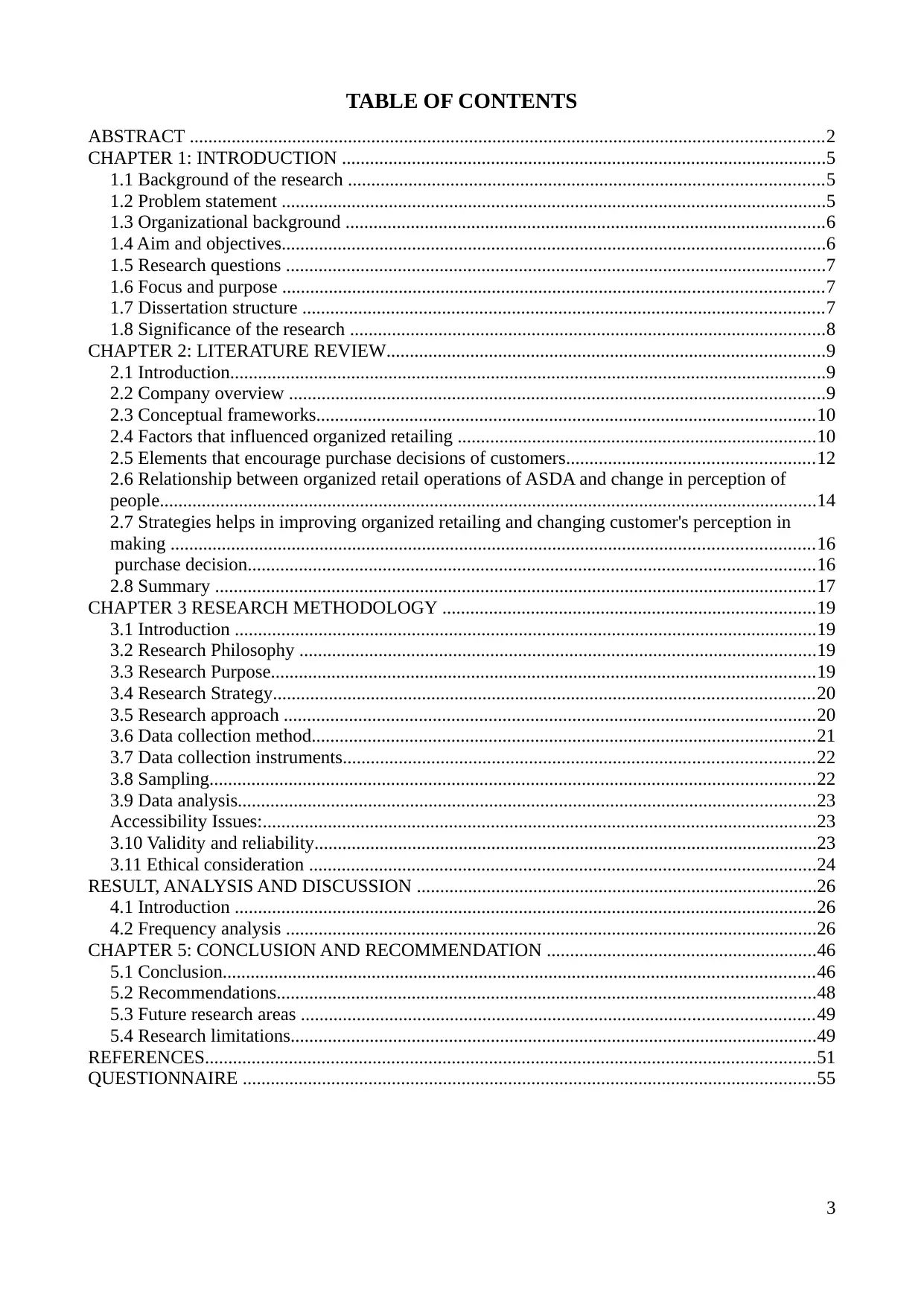
TABLE OF CONTENTS
ABSTRACT ........................................................................................................................................2
CHAPTER 1: INTRODUCTION ........................................................................................................5
1.1 Background of the research ......................................................................................................5
1.2 Problem statement .....................................................................................................................5
1.3 Organizational background .......................................................................................................6
1.4 Aim and objectives.....................................................................................................................6
1.5 Research questions ....................................................................................................................7
1.6 Focus and purpose ....................................................................................................................7
1.7 Dissertation structure ................................................................................................................7
1.8 Significance of the research ......................................................................................................8
CHAPTER 2: LITERATURE REVIEW..............................................................................................9
2.1 Introduction................................................................................................................................9
2.2 Company overview ...................................................................................................................9
2.3 Conceptual frameworks...........................................................................................................10
2.4 Factors that influenced organized retailing .............................................................................10
2.5 Elements that encourage purchase decisions of customers.....................................................12
2.6 Relationship between organized retail operations of ASDA and change in perception of
people.............................................................................................................................................14
2.7 Strategies helps in improving organized retailing and changing customer's perception in
making ..........................................................................................................................................16
purchase decision..........................................................................................................................16
2.8 Summary .................................................................................................................................17
CHAPTER 3 RESEARCH METHODOLOGY ................................................................................19
3.1 Introduction .............................................................................................................................19
3.2 Research Philosophy ...............................................................................................................19
3.3 Research Purpose.....................................................................................................................19
3.4 Research Strategy....................................................................................................................20
3.5 Research approach ..................................................................................................................20
3.6 Data collection method............................................................................................................21
3.7 Data collection instruments.....................................................................................................22
3.8 Sampling..................................................................................................................................22
3.9 Data analysis............................................................................................................................23
Accessibility Issues:.......................................................................................................................23
3.10 Validity and reliability............................................................................................................23
3.11 Ethical consideration .............................................................................................................24
RESULT, ANALYSIS AND DISCUSSION ......................................................................................26
4.1 Introduction .............................................................................................................................26
4.2 Frequency analysis ..................................................................................................................26
CHAPTER 5: CONCLUSION AND RECOMMENDATION ..........................................................46
5.1 Conclusion...............................................................................................................................46
5.2 Recommendations....................................................................................................................48
5.3 Future research areas ..............................................................................................................49
5.4 Research limitations.................................................................................................................49
REFERENCES...................................................................................................................................51
QUESTIONNAIRE ...........................................................................................................................55
3
ABSTRACT ........................................................................................................................................2
CHAPTER 1: INTRODUCTION ........................................................................................................5
1.1 Background of the research ......................................................................................................5
1.2 Problem statement .....................................................................................................................5
1.3 Organizational background .......................................................................................................6
1.4 Aim and objectives.....................................................................................................................6
1.5 Research questions ....................................................................................................................7
1.6 Focus and purpose ....................................................................................................................7
1.7 Dissertation structure ................................................................................................................7
1.8 Significance of the research ......................................................................................................8
CHAPTER 2: LITERATURE REVIEW..............................................................................................9
2.1 Introduction................................................................................................................................9
2.2 Company overview ...................................................................................................................9
2.3 Conceptual frameworks...........................................................................................................10
2.4 Factors that influenced organized retailing .............................................................................10
2.5 Elements that encourage purchase decisions of customers.....................................................12
2.6 Relationship between organized retail operations of ASDA and change in perception of
people.............................................................................................................................................14
2.7 Strategies helps in improving organized retailing and changing customer's perception in
making ..........................................................................................................................................16
purchase decision..........................................................................................................................16
2.8 Summary .................................................................................................................................17
CHAPTER 3 RESEARCH METHODOLOGY ................................................................................19
3.1 Introduction .............................................................................................................................19
3.2 Research Philosophy ...............................................................................................................19
3.3 Research Purpose.....................................................................................................................19
3.4 Research Strategy....................................................................................................................20
3.5 Research approach ..................................................................................................................20
3.6 Data collection method............................................................................................................21
3.7 Data collection instruments.....................................................................................................22
3.8 Sampling..................................................................................................................................22
3.9 Data analysis............................................................................................................................23
Accessibility Issues:.......................................................................................................................23
3.10 Validity and reliability............................................................................................................23
3.11 Ethical consideration .............................................................................................................24
RESULT, ANALYSIS AND DISCUSSION ......................................................................................26
4.1 Introduction .............................................................................................................................26
4.2 Frequency analysis ..................................................................................................................26
CHAPTER 5: CONCLUSION AND RECOMMENDATION ..........................................................46
5.1 Conclusion...............................................................................................................................46
5.2 Recommendations....................................................................................................................48
5.3 Future research areas ..............................................................................................................49
5.4 Research limitations.................................................................................................................49
REFERENCES...................................................................................................................................51
QUESTIONNAIRE ...........................................................................................................................55
3
⊘ This is a preview!⊘
Do you want full access?
Subscribe today to unlock all pages.

Trusted by 1+ million students worldwide
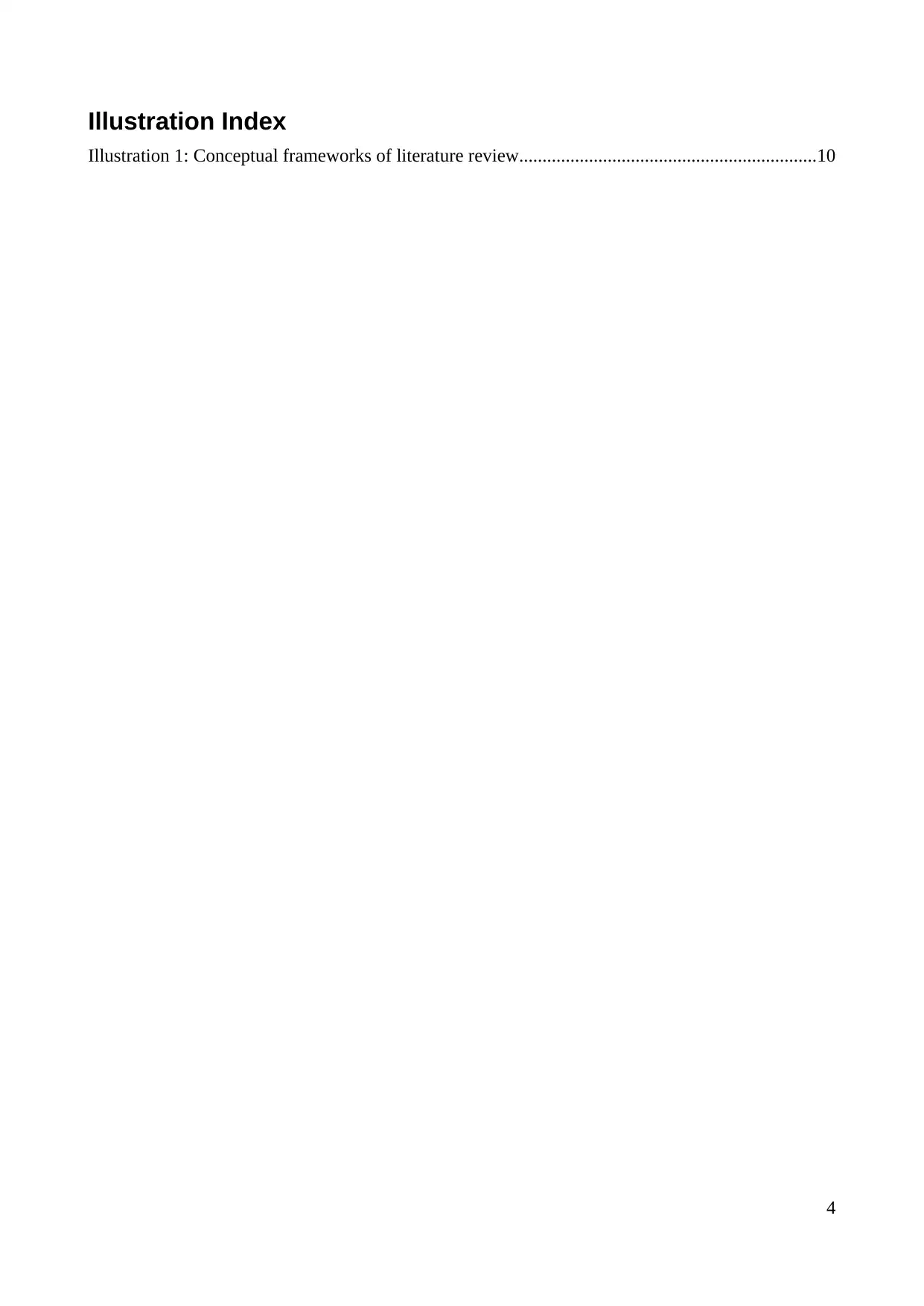
Illustration Index
Illustration 1: Conceptual frameworks of literature review................................................................10
4
Illustration 1: Conceptual frameworks of literature review................................................................10
4
Paraphrase This Document
Need a fresh take? Get an instant paraphrase of this document with our AI Paraphraser
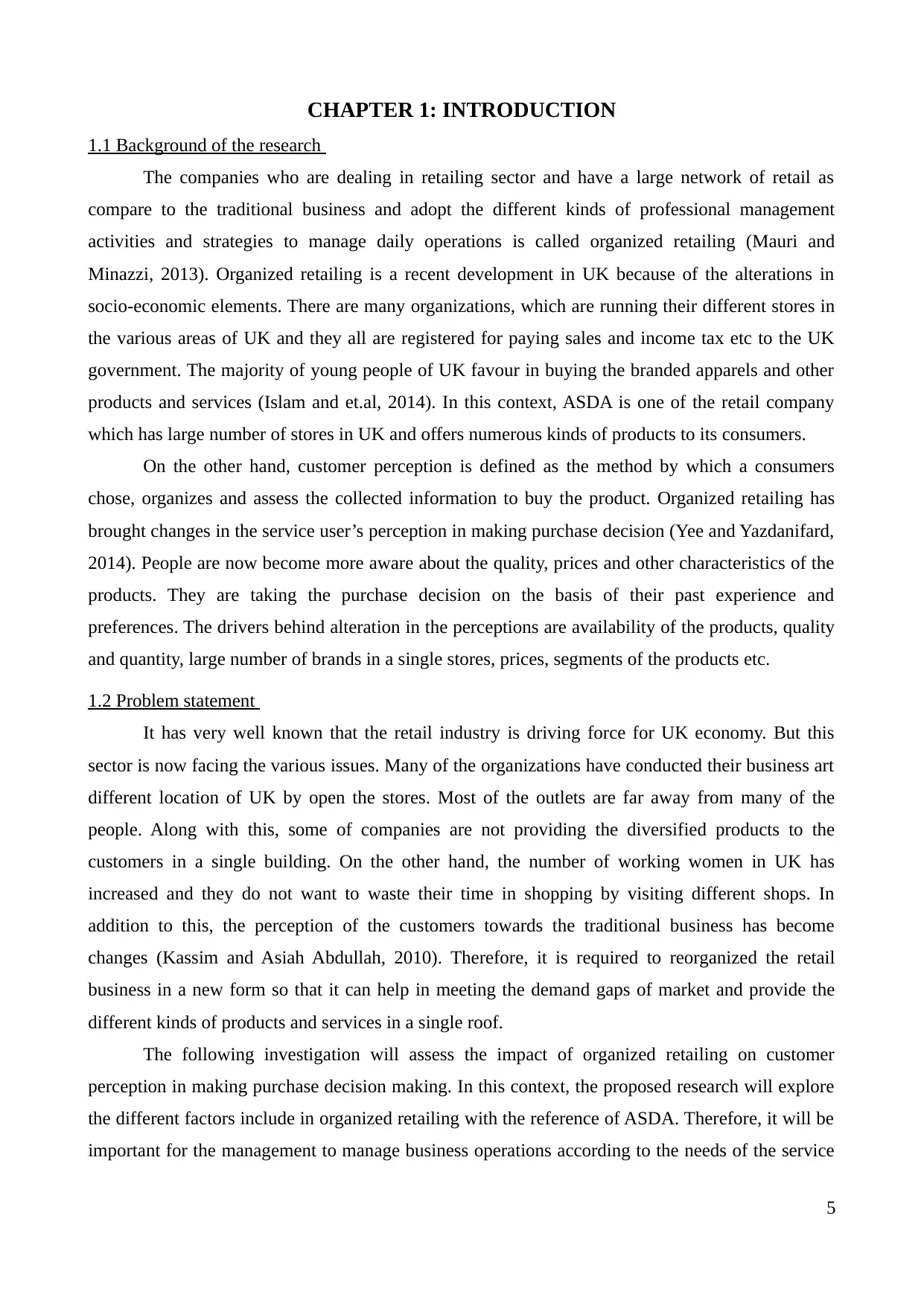
CHAPTER 1: INTRODUCTION
1.1 Background of the research
The companies who are dealing in retailing sector and have a large network of retail as
compare to the traditional business and adopt the different kinds of professional management
activities and strategies to manage daily operations is called organized retailing (Mauri and
Minazzi, 2013). Organized retailing is a recent development in UK because of the alterations in
socio-economic elements. There are many organizations, which are running their different stores in
the various areas of UK and they all are registered for paying sales and income tax etc to the UK
government. The majority of young people of UK favour in buying the branded apparels and other
products and services (Islam and et.al, 2014). In this context, ASDA is one of the retail company
which has large number of stores in UK and offers numerous kinds of products to its consumers.
On the other hand, customer perception is defined as the method by which a consumers
chose, organizes and assess the collected information to buy the product. Organized retailing has
brought changes in the service user’s perception in making purchase decision (Yee and Yazdanifard,
2014). People are now become more aware about the quality, prices and other characteristics of the
products. They are taking the purchase decision on the basis of their past experience and
preferences. The drivers behind alteration in the perceptions are availability of the products, quality
and quantity, large number of brands in a single stores, prices, segments of the products etc.
1.2 Problem statement
It has very well known that the retail industry is driving force for UK economy. But this
sector is now facing the various issues. Many of the organizations have conducted their business art
different location of UK by open the stores. Most of the outlets are far away from many of the
people. Along with this, some of companies are not providing the diversified products to the
customers in a single building. On the other hand, the number of working women in UK has
increased and they do not want to waste their time in shopping by visiting different shops. In
addition to this, the perception of the customers towards the traditional business has become
changes (Kassim and Asiah Abdullah, 2010). Therefore, it is required to reorganized the retail
business in a new form so that it can help in meeting the demand gaps of market and provide the
different kinds of products and services in a single roof.
The following investigation will assess the impact of organized retailing on customer
perception in making purchase decision making. In this context, the proposed research will explore
the different factors include in organized retailing with the reference of ASDA. Therefore, it will be
important for the management to manage business operations according to the needs of the service
5
1.1 Background of the research
The companies who are dealing in retailing sector and have a large network of retail as
compare to the traditional business and adopt the different kinds of professional management
activities and strategies to manage daily operations is called organized retailing (Mauri and
Minazzi, 2013). Organized retailing is a recent development in UK because of the alterations in
socio-economic elements. There are many organizations, which are running their different stores in
the various areas of UK and they all are registered for paying sales and income tax etc to the UK
government. The majority of young people of UK favour in buying the branded apparels and other
products and services (Islam and et.al, 2014). In this context, ASDA is one of the retail company
which has large number of stores in UK and offers numerous kinds of products to its consumers.
On the other hand, customer perception is defined as the method by which a consumers
chose, organizes and assess the collected information to buy the product. Organized retailing has
brought changes in the service user’s perception in making purchase decision (Yee and Yazdanifard,
2014). People are now become more aware about the quality, prices and other characteristics of the
products. They are taking the purchase decision on the basis of their past experience and
preferences. The drivers behind alteration in the perceptions are availability of the products, quality
and quantity, large number of brands in a single stores, prices, segments of the products etc.
1.2 Problem statement
It has very well known that the retail industry is driving force for UK economy. But this
sector is now facing the various issues. Many of the organizations have conducted their business art
different location of UK by open the stores. Most of the outlets are far away from many of the
people. Along with this, some of companies are not providing the diversified products to the
customers in a single building. On the other hand, the number of working women in UK has
increased and they do not want to waste their time in shopping by visiting different shops. In
addition to this, the perception of the customers towards the traditional business has become
changes (Kassim and Asiah Abdullah, 2010). Therefore, it is required to reorganized the retail
business in a new form so that it can help in meeting the demand gaps of market and provide the
different kinds of products and services in a single roof.
The following investigation will assess the impact of organized retailing on customer
perception in making purchase decision making. In this context, the proposed research will explore
the different factors include in organized retailing with the reference of ASDA. Therefore, it will be
important for the management to manage business operations according to the needs of the service
5
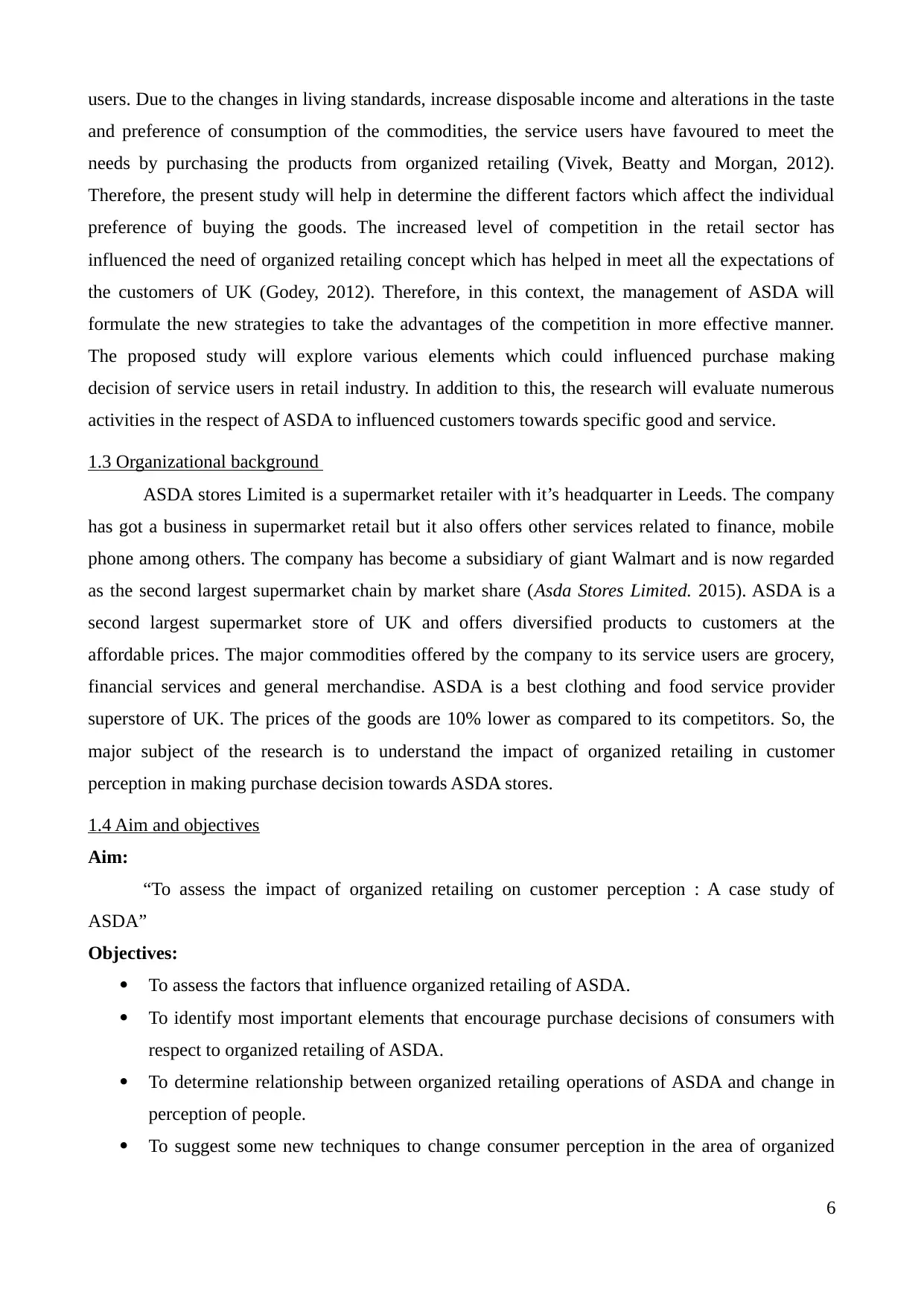
users. Due to the changes in living standards, increase disposable income and alterations in the taste
and preference of consumption of the commodities, the service users have favoured to meet the
needs by purchasing the products from organized retailing (Vivek, Beatty and Morgan, 2012).
Therefore, the present study will help in determine the different factors which affect the individual
preference of buying the goods. The increased level of competition in the retail sector has
influenced the need of organized retailing concept which has helped in meet all the expectations of
the customers of UK (Godey, 2012). Therefore, in this context, the management of ASDA will
formulate the new strategies to take the advantages of the competition in more effective manner.
The proposed study will explore various elements which could influenced purchase making
decision of service users in retail industry. In addition to this, the research will evaluate numerous
activities in the respect of ASDA to influenced customers towards specific good and service.
1.3 Organizational background
ASDA stores Limited is a supermarket retailer with it’s headquarter in Leeds. The company
has got a business in supermarket retail but it also offers other services related to finance, mobile
phone among others. The company has become a subsidiary of giant Walmart and is now regarded
as the second largest supermarket chain by market share (Asda Stores Limited. 2015). ASDA is a
second largest supermarket store of UK and offers diversified products to customers at the
affordable prices. The major commodities offered by the company to its service users are grocery,
financial services and general merchandise. ASDA is a best clothing and food service provider
superstore of UK. The prices of the goods are 10% lower as compared to its competitors. So, the
major subject of the research is to understand the impact of organized retailing in customer
perception in making purchase decision towards ASDA stores.
1.4 Aim and objectives
Aim:
“To assess the impact of organized retailing on customer perception : A case study of
ASDA”
Objectives:
To assess the factors that influence organized retailing of ASDA.
To identify most important elements that encourage purchase decisions of consumers with
respect to organized retailing of ASDA.
To determine relationship between organized retailing operations of ASDA and change in
perception of people.
To suggest some new techniques to change consumer perception in the area of organized
6
and preference of consumption of the commodities, the service users have favoured to meet the
needs by purchasing the products from organized retailing (Vivek, Beatty and Morgan, 2012).
Therefore, the present study will help in determine the different factors which affect the individual
preference of buying the goods. The increased level of competition in the retail sector has
influenced the need of organized retailing concept which has helped in meet all the expectations of
the customers of UK (Godey, 2012). Therefore, in this context, the management of ASDA will
formulate the new strategies to take the advantages of the competition in more effective manner.
The proposed study will explore various elements which could influenced purchase making
decision of service users in retail industry. In addition to this, the research will evaluate numerous
activities in the respect of ASDA to influenced customers towards specific good and service.
1.3 Organizational background
ASDA stores Limited is a supermarket retailer with it’s headquarter in Leeds. The company
has got a business in supermarket retail but it also offers other services related to finance, mobile
phone among others. The company has become a subsidiary of giant Walmart and is now regarded
as the second largest supermarket chain by market share (Asda Stores Limited. 2015). ASDA is a
second largest supermarket store of UK and offers diversified products to customers at the
affordable prices. The major commodities offered by the company to its service users are grocery,
financial services and general merchandise. ASDA is a best clothing and food service provider
superstore of UK. The prices of the goods are 10% lower as compared to its competitors. So, the
major subject of the research is to understand the impact of organized retailing in customer
perception in making purchase decision towards ASDA stores.
1.4 Aim and objectives
Aim:
“To assess the impact of organized retailing on customer perception : A case study of
ASDA”
Objectives:
To assess the factors that influence organized retailing of ASDA.
To identify most important elements that encourage purchase decisions of consumers with
respect to organized retailing of ASDA.
To determine relationship between organized retailing operations of ASDA and change in
perception of people.
To suggest some new techniques to change consumer perception in the area of organized
6
⊘ This is a preview!⊘
Do you want full access?
Subscribe today to unlock all pages.

Trusted by 1+ million students worldwide

retailing of ASDA.
1.5 Research questions
1. What are the major factors that influence the organized retailing of ASDA?
2. What are most important aspects of retail industry that encourage purchase decisions of
consumers in organized retailing of ASDA?
3. Which strategies can help in improving organized retailing of ASDA and changing
customer's perception in making purchase decision?
1.6 Focus and purpose
To achieve the objectives of the following study, the researcher will focus on organized
retailing concept of ASDA. It will also shed light on the numerous factors which influenced
organized retailing and its relationship with the customer decision making. Along with this, the
researcher will try to define those elements which encourages the customers to change the decision
making perception regarding buying the products from ASDA organized retailing. On the other
hand, the new techniques will be suggested by the investigator related to customer management of
ASDA by which it will take the advantages of the increase competition in the organized retail
market. The purpose of researcher behind conducting the following research is determine the impact
of organized retailing on customer perception in making purchase decision.
1.7 Dissertation structure
The following research will based on to explore the impacts of organized retailing on
customer perception in making purchase decision making. Hence, the structure of the whole
investigation is as follows.
Chapter 1: Introduction – The following section will provide the information related to the
background of study. It will include the description of organized retailing and customer perceptions
during buying the goods and services. Along with this, it will describe the research issue and
organization background. The introduction chapter will also explain the aim, objectives, research
questions, focus and purpose of the research etc. At the end of the following section, the complete
structure, research methodology and framework and analysis will used for complete the whole work
on impact of organized retailing of ASDA on customer perception in buying decision making
process.
Chapter 2: Literature review and conceptual framework – This section will provide an insight for
conducting the study in the well manner. It will include the previous studies of the other researchers
on the similar topic of organized retailing and its impact on customer perception while taking the
decision of purchasing. Along with this, the different kinds of theories will be used by the
7
1.5 Research questions
1. What are the major factors that influence the organized retailing of ASDA?
2. What are most important aspects of retail industry that encourage purchase decisions of
consumers in organized retailing of ASDA?
3. Which strategies can help in improving organized retailing of ASDA and changing
customer's perception in making purchase decision?
1.6 Focus and purpose
To achieve the objectives of the following study, the researcher will focus on organized
retailing concept of ASDA. It will also shed light on the numerous factors which influenced
organized retailing and its relationship with the customer decision making. Along with this, the
researcher will try to define those elements which encourages the customers to change the decision
making perception regarding buying the products from ASDA organized retailing. On the other
hand, the new techniques will be suggested by the investigator related to customer management of
ASDA by which it will take the advantages of the increase competition in the organized retail
market. The purpose of researcher behind conducting the following research is determine the impact
of organized retailing on customer perception in making purchase decision.
1.7 Dissertation structure
The following research will based on to explore the impacts of organized retailing on
customer perception in making purchase decision making. Hence, the structure of the whole
investigation is as follows.
Chapter 1: Introduction – The following section will provide the information related to the
background of study. It will include the description of organized retailing and customer perceptions
during buying the goods and services. Along with this, it will describe the research issue and
organization background. The introduction chapter will also explain the aim, objectives, research
questions, focus and purpose of the research etc. At the end of the following section, the complete
structure, research methodology and framework and analysis will used for complete the whole work
on impact of organized retailing of ASDA on customer perception in buying decision making
process.
Chapter 2: Literature review and conceptual framework – This section will provide an insight for
conducting the study in the well manner. It will include the previous studies of the other researchers
on the similar topic of organized retailing and its impact on customer perception while taking the
decision of purchasing. Along with this, the different kinds of theories will be used by the
7
Paraphrase This Document
Need a fresh take? Get an instant paraphrase of this document with our AI Paraphraser

researcher to obtain the clear fasts related to organized retailing.
Chapter 3: Research design and methodology – Under this section, the various types of tools and
techniques will used by the scholar to conduct the research on the proposed objectives. It will help
in make the comparison between the expected and actual results. The methods which will used by
the researcher in the proposed research are research techniques, approach, data collection, sampling,
ethical consideration etc (Blakstad, 2015).
Chapter 4: Result, analysis and discussion – The numerous kinds of tools and techniques will used
by research to collect the data and analyse the fact and figures. For assessment of impact of
organized retailing for ASDA, the researcher will use quantitative research technique.
Chapter 5: Conclusion and recommendations – This chapter will include the meaningful
conclusion as per the findings in the data analysis and discussion section. In addition to this, some
recommendations will give by the researcher in the respect of customer management to ASDA for
managing tough competition in organized retail sector.
1.8 Significance of the research
The given research study holds significance for the all the retailing organizations spread over
UK for assessing the consumer perception in order to make purchase decision. The learning from
the study also holds significance for other industries that wish to make a survey on customer
perception with respect to their purchase decisions. This investigation will help in determining the
impact of the organized retailing with the customer perception. Other retail organisations can also
use this investigation for improving their strategies along with the customer expectations. This
study will help in understanding the various perceptions of the users with respect to the organized
retailing and by using these perceptions, companies can improve their strategies for effective
accomplishment of their objectives. In addition to it, Ph.D. students can also use this research for
getting more knowledge and its literature review will help them in understanding the facts and
figures with respect to the retail marketing and customer perception.
8
Chapter 3: Research design and methodology – Under this section, the various types of tools and
techniques will used by the scholar to conduct the research on the proposed objectives. It will help
in make the comparison between the expected and actual results. The methods which will used by
the researcher in the proposed research are research techniques, approach, data collection, sampling,
ethical consideration etc (Blakstad, 2015).
Chapter 4: Result, analysis and discussion – The numerous kinds of tools and techniques will used
by research to collect the data and analyse the fact and figures. For assessment of impact of
organized retailing for ASDA, the researcher will use quantitative research technique.
Chapter 5: Conclusion and recommendations – This chapter will include the meaningful
conclusion as per the findings in the data analysis and discussion section. In addition to this, some
recommendations will give by the researcher in the respect of customer management to ASDA for
managing tough competition in organized retail sector.
1.8 Significance of the research
The given research study holds significance for the all the retailing organizations spread over
UK for assessing the consumer perception in order to make purchase decision. The learning from
the study also holds significance for other industries that wish to make a survey on customer
perception with respect to their purchase decisions. This investigation will help in determining the
impact of the organized retailing with the customer perception. Other retail organisations can also
use this investigation for improving their strategies along with the customer expectations. This
study will help in understanding the various perceptions of the users with respect to the organized
retailing and by using these perceptions, companies can improve their strategies for effective
accomplishment of their objectives. In addition to it, Ph.D. students can also use this research for
getting more knowledge and its literature review will help them in understanding the facts and
figures with respect to the retail marketing and customer perception.
8
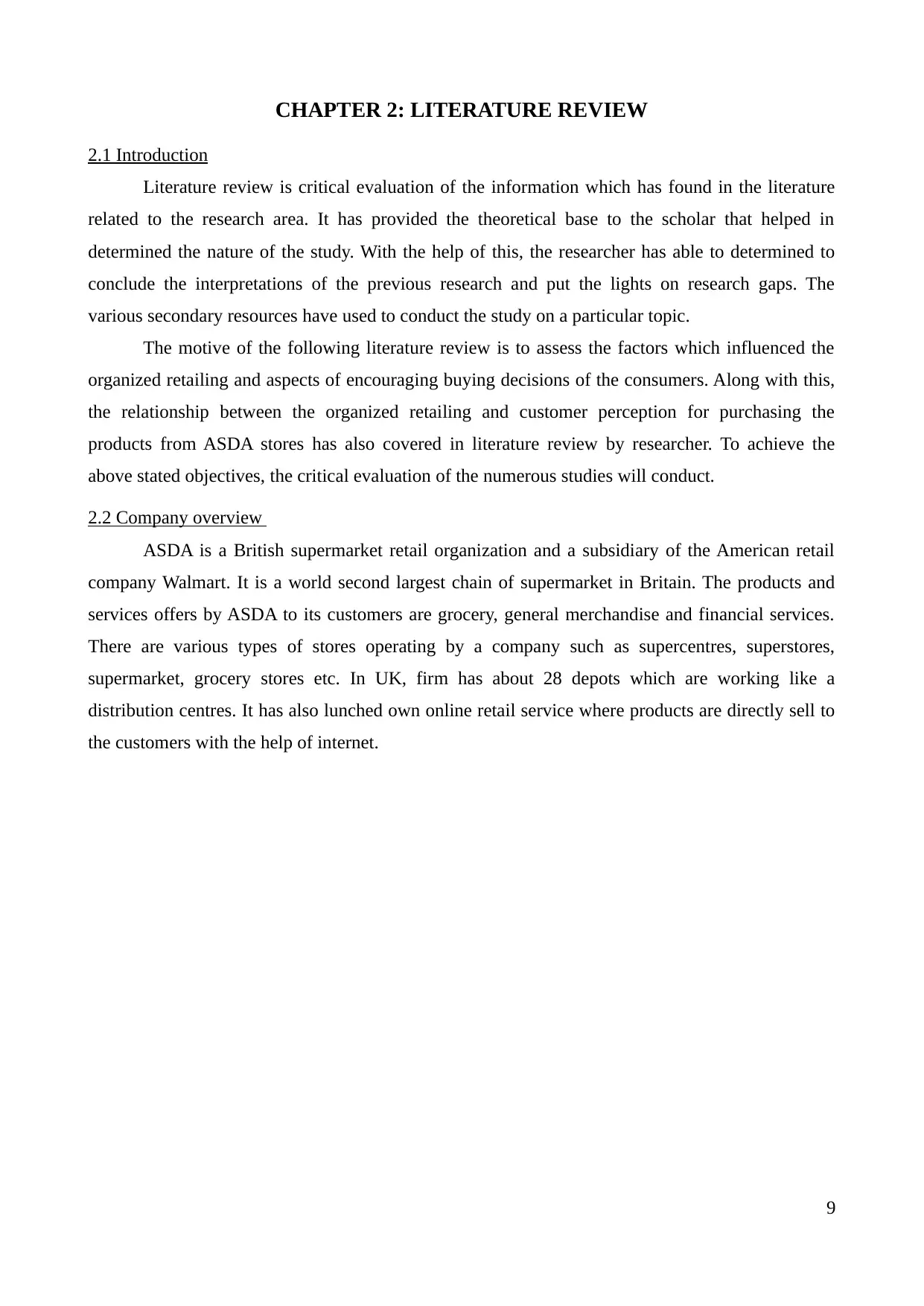
CHAPTER 2: LITERATURE REVIEW
2.1 Introduction
Literature review is critical evaluation of the information which has found in the literature
related to the research area. It has provided the theoretical base to the scholar that helped in
determined the nature of the study. With the help of this, the researcher has able to determined to
conclude the interpretations of the previous research and put the lights on research gaps. The
various secondary resources have used to conduct the study on a particular topic.
The motive of the following literature review is to assess the factors which influenced the
organized retailing and aspects of encouraging buying decisions of the consumers. Along with this,
the relationship between the organized retailing and customer perception for purchasing the
products from ASDA stores has also covered in literature review by researcher. To achieve the
above stated objectives, the critical evaluation of the numerous studies will conduct.
2.2 Company overview
ASDA is a British supermarket retail organization and a subsidiary of the American retail
company Walmart. It is a world second largest chain of supermarket in Britain. The products and
services offers by ASDA to its customers are grocery, general merchandise and financial services.
There are various types of stores operating by a company such as supercentres, superstores,
supermarket, grocery stores etc. In UK, firm has about 28 depots which are working like a
distribution centres. It has also lunched own online retail service where products are directly sell to
the customers with the help of internet.
9
2.1 Introduction
Literature review is critical evaluation of the information which has found in the literature
related to the research area. It has provided the theoretical base to the scholar that helped in
determined the nature of the study. With the help of this, the researcher has able to determined to
conclude the interpretations of the previous research and put the lights on research gaps. The
various secondary resources have used to conduct the study on a particular topic.
The motive of the following literature review is to assess the factors which influenced the
organized retailing and aspects of encouraging buying decisions of the consumers. Along with this,
the relationship between the organized retailing and customer perception for purchasing the
products from ASDA stores has also covered in literature review by researcher. To achieve the
above stated objectives, the critical evaluation of the numerous studies will conduct.
2.2 Company overview
ASDA is a British supermarket retail organization and a subsidiary of the American retail
company Walmart. It is a world second largest chain of supermarket in Britain. The products and
services offers by ASDA to its customers are grocery, general merchandise and financial services.
There are various types of stores operating by a company such as supercentres, superstores,
supermarket, grocery stores etc. In UK, firm has about 28 depots which are working like a
distribution centres. It has also lunched own online retail service where products are directly sell to
the customers with the help of internet.
9
⊘ This is a preview!⊘
Do you want full access?
Subscribe today to unlock all pages.

Trusted by 1+ million students worldwide
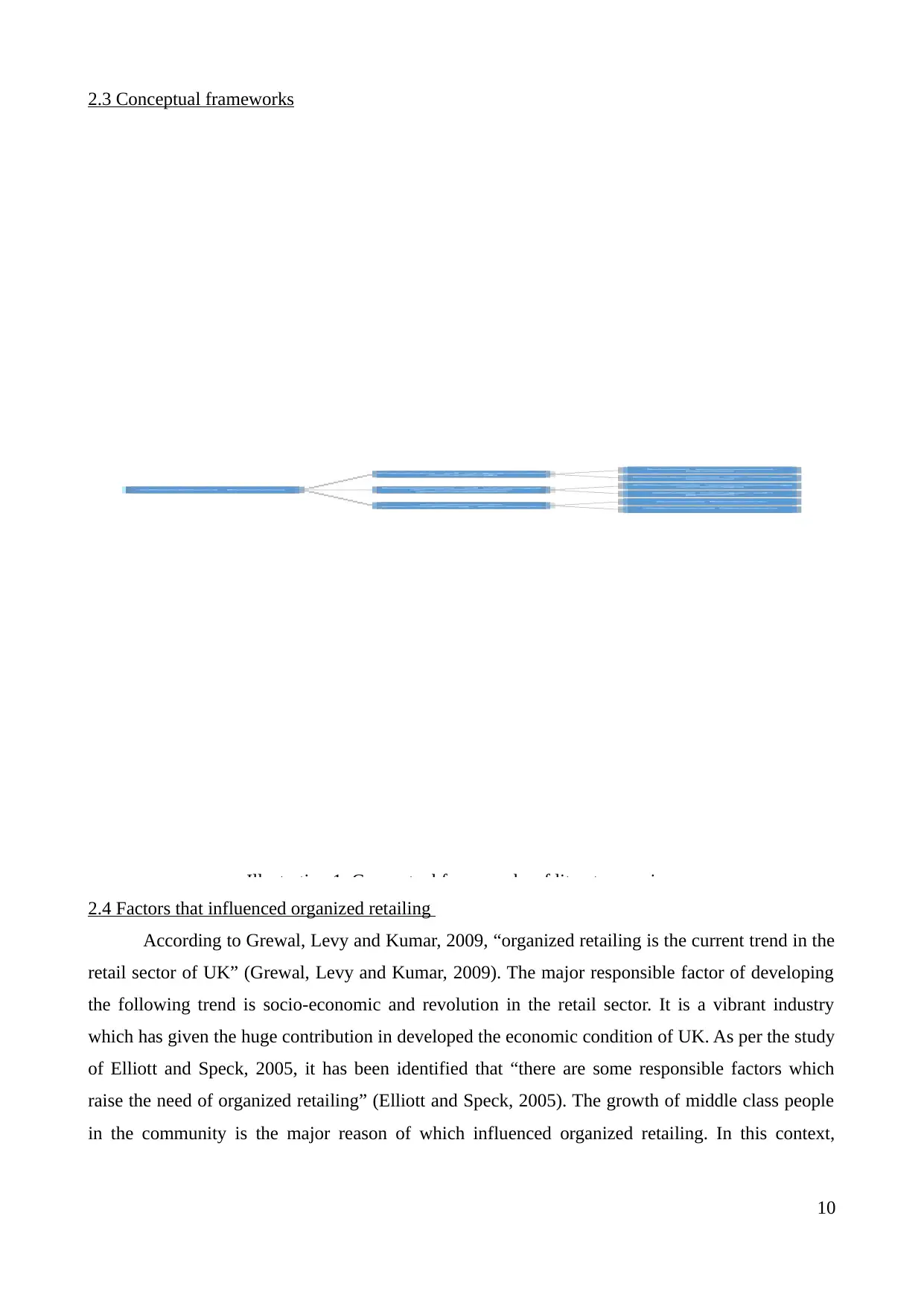
2.3 Conceptual frameworks
Illustration 1: Conceptual frameworks of literature review
2.4 Factors that influenced organized retailing
According to Grewal, Levy and Kumar, 2009, “organized retailing is the current trend in the
retail sector of UK” (Grewal, Levy and Kumar, 2009). The major responsible factor of developing
the following trend is socio-economic and revolution in the retail sector. It is a vibrant industry
which has given the huge contribution in developed the economic condition of UK. As per the study
of Elliott and Speck, 2005, it has been identified that “there are some responsible factors which
raise the need of organized retailing” (Elliott and Speck, 2005). The growth of middle class people
in the community is the major reason of which influenced organized retailing. In this context,
10
Illustration 1: Conceptual frameworks of literature review
2.4 Factors that influenced organized retailing
According to Grewal, Levy and Kumar, 2009, “organized retailing is the current trend in the
retail sector of UK” (Grewal, Levy and Kumar, 2009). The major responsible factor of developing
the following trend is socio-economic and revolution in the retail sector. It is a vibrant industry
which has given the huge contribution in developed the economic condition of UK. As per the study
of Elliott and Speck, 2005, it has been identified that “there are some responsible factors which
raise the need of organized retailing” (Elliott and Speck, 2005). The growth of middle class people
in the community is the major reason of which influenced organized retailing. In this context,
10
Paraphrase This Document
Need a fresh take? Get an instant paraphrase of this document with our AI Paraphraser

Srivastava, 2008 has stated that “the number of middle class families in UK has increased with the
high speed. It has enhanced the demands of the products and services in the community”
(Srivastava, 2008). The disposable income of the people have also raised which has provided the
large opportunity to the retail sector to grow and sever the large area. Similarly, Puccinelli,
Goodstein and et.al., 2009 has explained in his research that “the customers are expecting the good
quality of commodities in the nice prices which is one of the responsible factor of growth of
organized retailing in UK” (Puccinelli, Goodstein and et.al., 2009). Due to the change in
expectation of the service users, many of the retail organizations such as ASDA has offered the
diversified range of the goods to the target market and that has able to delivered the valued services
to the customers.
On the other hand, Miranda, Konya and Havrila, 2005 has suggested that “the number of
working females in UK has increased and they have well literate as well as highly qualified”
(Miranda, Konya and Havrila, 2005). The working women have the skill to manage the work of
home and office very well. Their buying habit is different from the home maker because they want
all the products and services in a single roof. This thing has generated the requirement of organized
retailing. But Hutchinson, Quinn and Alexander, 2006 has suggested that “for getting the value for
money as well as gain the high economic of scale from manufacturing and distribution”
(Hutchinson, Quinn and Alexander, 2006). The organized retailing helps in eliminating the
intermediaries from the distribution channel and due to this, the retail organizations able to offers
the goods and services at the affordable prices. Therefore, the more profit has attracted the different
retail companies to run the business in organized manner and this things has raised the needs of
organized retailing. According to Chand, 2015 “rural markets are emerging very fast in the present
time and they are facing the strong competition in the retail industry” (Chand, 2015). In the
developing nations such as India, there are immense potential in the people who are living in rural
areas. Now, they are manufacturing the new products which satisfy the needs of the community in
the effective manner. Like in India, retail sector has able to provided the large employment to the
people and it has also support the economic condition of the country.
In the contrast of the above statement, Brown, Barry, Dacin and Gunst, 2005 has stated that
“entry of corporate sector into the retail sector has responsible factor of need of organized retailing”
(Brown, Barry, Dacin and Gunst, 2005). The different business leaders have entered into retail
industry because they are having the strong financial position to supply good quality commodities at
affordable prices to the community. Similarly, Ali, Kapoor and Moorthy, 2010 has asserted that
“many foreign retailers are now entering into the various nations via different market entry
strategies such as franchising, joint venture etc” (Ali, Kapoor and Moorthy, 2010). Hence, it has
11
high speed. It has enhanced the demands of the products and services in the community”
(Srivastava, 2008). The disposable income of the people have also raised which has provided the
large opportunity to the retail sector to grow and sever the large area. Similarly, Puccinelli,
Goodstein and et.al., 2009 has explained in his research that “the customers are expecting the good
quality of commodities in the nice prices which is one of the responsible factor of growth of
organized retailing in UK” (Puccinelli, Goodstein and et.al., 2009). Due to the change in
expectation of the service users, many of the retail organizations such as ASDA has offered the
diversified range of the goods to the target market and that has able to delivered the valued services
to the customers.
On the other hand, Miranda, Konya and Havrila, 2005 has suggested that “the number of
working females in UK has increased and they have well literate as well as highly qualified”
(Miranda, Konya and Havrila, 2005). The working women have the skill to manage the work of
home and office very well. Their buying habit is different from the home maker because they want
all the products and services in a single roof. This thing has generated the requirement of organized
retailing. But Hutchinson, Quinn and Alexander, 2006 has suggested that “for getting the value for
money as well as gain the high economic of scale from manufacturing and distribution”
(Hutchinson, Quinn and Alexander, 2006). The organized retailing helps in eliminating the
intermediaries from the distribution channel and due to this, the retail organizations able to offers
the goods and services at the affordable prices. Therefore, the more profit has attracted the different
retail companies to run the business in organized manner and this things has raised the needs of
organized retailing. According to Chand, 2015 “rural markets are emerging very fast in the present
time and they are facing the strong competition in the retail industry” (Chand, 2015). In the
developing nations such as India, there are immense potential in the people who are living in rural
areas. Now, they are manufacturing the new products which satisfy the needs of the community in
the effective manner. Like in India, retail sector has able to provided the large employment to the
people and it has also support the economic condition of the country.
In the contrast of the above statement, Brown, Barry, Dacin and Gunst, 2005 has stated that
“entry of corporate sector into the retail sector has responsible factor of need of organized retailing”
(Brown, Barry, Dacin and Gunst, 2005). The different business leaders have entered into retail
industry because they are having the strong financial position to supply good quality commodities at
affordable prices to the community. Similarly, Ali, Kapoor and Moorthy, 2010 has asserted that
“many foreign retailers are now entering into the various nations via different market entry
strategies such as franchising, joint venture etc” (Ali, Kapoor and Moorthy, 2010). Hence, it has
11
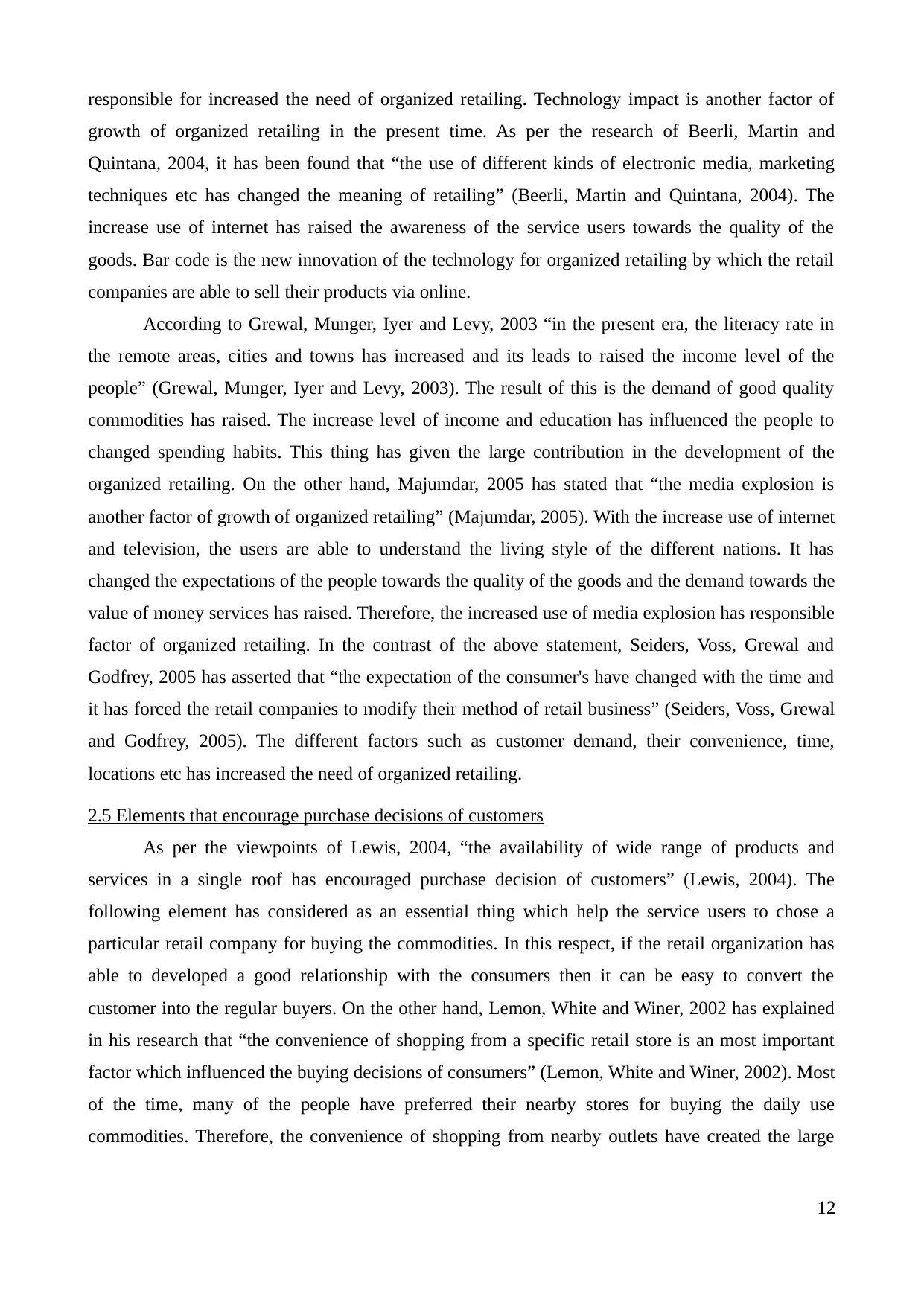
responsible for increased the need of organized retailing. Technology impact is another factor of
growth of organized retailing in the present time. As per the research of Beerli, Martin and
Quintana, 2004, it has been found that “the use of different kinds of electronic media, marketing
techniques etc has changed the meaning of retailing” (Beerli, Martin and Quintana, 2004). The
increase use of internet has raised the awareness of the service users towards the quality of the
goods. Bar code is the new innovation of the technology for organized retailing by which the retail
companies are able to sell their products via online.
According to Grewal, Munger, Iyer and Levy, 2003 “in the present era, the literacy rate in
the remote areas, cities and towns has increased and its leads to raised the income level of the
people” (Grewal, Munger, Iyer and Levy, 2003). The result of this is the demand of good quality
commodities has raised. The increase level of income and education has influenced the people to
changed spending habits. This thing has given the large contribution in the development of the
organized retailing. On the other hand, Majumdar, 2005 has stated that “the media explosion is
another factor of growth of organized retailing” (Majumdar, 2005). With the increase use of internet
and television, the users are able to understand the living style of the different nations. It has
changed the expectations of the people towards the quality of the goods and the demand towards the
value of money services has raised. Therefore, the increased use of media explosion has responsible
factor of organized retailing. In the contrast of the above statement, Seiders, Voss, Grewal and
Godfrey, 2005 has asserted that “the expectation of the consumer's have changed with the time and
it has forced the retail companies to modify their method of retail business” (Seiders, Voss, Grewal
and Godfrey, 2005). The different factors such as customer demand, their convenience, time,
locations etc has increased the need of organized retailing.
2.5 Elements that encourage purchase decisions of customers
As per the viewpoints of Lewis, 2004, “the availability of wide range of products and
services in a single roof has encouraged purchase decision of customers” (Lewis, 2004). The
following element has considered as an essential thing which help the service users to chose a
particular retail company for buying the commodities. In this respect, if the retail organization has
able to developed a good relationship with the consumers then it can be easy to convert the
customer into the regular buyers. On the other hand, Lemon, White and Winer, 2002 has explained
in his research that “the convenience of shopping from a specific retail store is an most important
factor which influenced the buying decisions of consumers” (Lemon, White and Winer, 2002). Most
of the time, many of the people have preferred their nearby stores for buying the daily use
commodities. Therefore, the convenience of shopping from nearby outlets have created the large
12
growth of organized retailing in the present time. As per the research of Beerli, Martin and
Quintana, 2004, it has been found that “the use of different kinds of electronic media, marketing
techniques etc has changed the meaning of retailing” (Beerli, Martin and Quintana, 2004). The
increase use of internet has raised the awareness of the service users towards the quality of the
goods. Bar code is the new innovation of the technology for organized retailing by which the retail
companies are able to sell their products via online.
According to Grewal, Munger, Iyer and Levy, 2003 “in the present era, the literacy rate in
the remote areas, cities and towns has increased and its leads to raised the income level of the
people” (Grewal, Munger, Iyer and Levy, 2003). The result of this is the demand of good quality
commodities has raised. The increase level of income and education has influenced the people to
changed spending habits. This thing has given the large contribution in the development of the
organized retailing. On the other hand, Majumdar, 2005 has stated that “the media explosion is
another factor of growth of organized retailing” (Majumdar, 2005). With the increase use of internet
and television, the users are able to understand the living style of the different nations. It has
changed the expectations of the people towards the quality of the goods and the demand towards the
value of money services has raised. Therefore, the increased use of media explosion has responsible
factor of organized retailing. In the contrast of the above statement, Seiders, Voss, Grewal and
Godfrey, 2005 has asserted that “the expectation of the consumer's have changed with the time and
it has forced the retail companies to modify their method of retail business” (Seiders, Voss, Grewal
and Godfrey, 2005). The different factors such as customer demand, their convenience, time,
locations etc has increased the need of organized retailing.
2.5 Elements that encourage purchase decisions of customers
As per the viewpoints of Lewis, 2004, “the availability of wide range of products and
services in a single roof has encouraged purchase decision of customers” (Lewis, 2004). The
following element has considered as an essential thing which help the service users to chose a
particular retail company for buying the commodities. In this respect, if the retail organization has
able to developed a good relationship with the consumers then it can be easy to convert the
customer into the regular buyers. On the other hand, Lemon, White and Winer, 2002 has explained
in his research that “the convenience of shopping from a specific retail store is an most important
factor which influenced the buying decisions of consumers” (Lemon, White and Winer, 2002). Most
of the time, many of the people have preferred their nearby stores for buying the daily use
commodities. Therefore, the convenience of shopping from nearby outlets have created the large
12
⊘ This is a preview!⊘
Do you want full access?
Subscribe today to unlock all pages.

Trusted by 1+ million students worldwide
1 out of 59
Related Documents
Your All-in-One AI-Powered Toolkit for Academic Success.
+13062052269
info@desklib.com
Available 24*7 on WhatsApp / Email
![[object Object]](/_next/static/media/star-bottom.7253800d.svg)
Unlock your academic potential
Copyright © 2020–2025 A2Z Services. All Rights Reserved. Developed and managed by ZUCOL.





